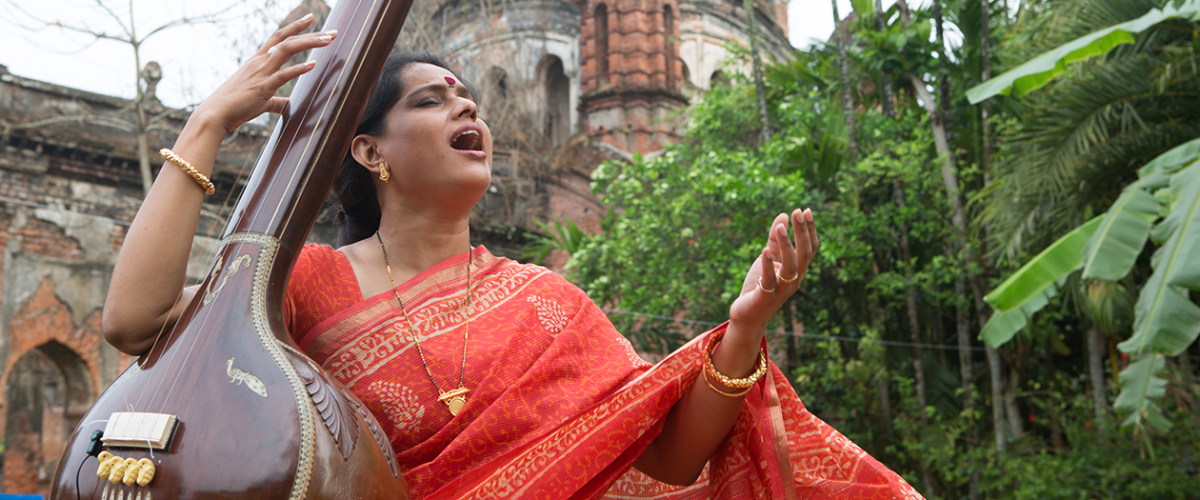

Khayal is now the most dominant form of North Indian classical vocal music. The word (also spelt khyal) comes from the Persian for imagination because it offers the performer more freedom and a greater scope for improvisation than the older vocal genre known as Dhrupad. Even so, khayal demands strict adherence to the musical grammar of the chosen raag (melodic structure).
Its origins are something of a controversy among music scholars, but many attribute its roots to the 14th century song form known as qawwali, a devotional genre of the Sufis (Islamic mystics) of North India. In simplistic terms, many sources have cited khayal as a more ‘romantic’ song-form than Dhrupad and, by the middle of the 19th century, khayal had all but eclipsed Dhrupad as the preferred vocal style for royal courts as well as other performance gatherings of musicians.
Khayal is normally based on song-texts called bandish (compositions), which can be as short as four lines - but the opportunities for musical improvisation are so numerous and varied that a competent performer can easily stretch two or four lines of verse to last through a performance of over an hour. The language is usually an older form of Hindi known as Braj Bhasha but it can also be old Punjabi with lyrical themes varying from eulogies of gods or kings to descriptions of nature and everyday life, touching upon human as well as divine love.
As the song text is minimal and the stress is on musical technique, words do not have to be as clearly enunciated as in other vocal genres. Singers may also resort to sounds other than the words of the song-text, either open-ended syllables to elongate melodic passages known as taans, or the actual names of the relevant musical notes: Sa, Re, Ga, Ma, Pa, Dha, Ni, Sa.
Khayal is nearly always sung solo, although there is now a growing tendency for advanced students to provide support vocals shadowing the maestro. Traditionally, melodic accompaniment for this genre was the sarangi (a boxed lute, played with a bow) but it is now more usual to see the keyboard-like harmonium.
Percussion is always on the tabla (the North Indian drum played in two halves, the development and refinement of which seems to parallel the development of khayal itself), as well as the tanpura. The latter provides a drone, creating a back-drop which helps the singer maintain perfect pitch (although nowadays the tanpura can be replaced by an electronic device known as a shruti box). Some singers, (particularly those of the old school) will often also hold and play the swarmandal, a sort of zither.
A khayal recital begins with a vilambit (slow tempo) introduction called bada khayal (big, long) which forms the bulk of the performance, followed by a madhya (medium-speed) section and ending in chhota (small, brief) khayal which is in a faster tempo, known as drut and which usually features a different text composition. But while this faster section is usually in a different tala (rhythm cycle), it must still be in the same raag as the slower, opening section.
Some performers follow up this fast section with the addition of a tarana - a fast-tempo rhythmic piece consisting of syllables drawn from Persian words and the names of various drum-beats. The tarana, which is performed in the same raag as the preceding sections, has definite origins in qawwali, the devotional music of South Asian Sufi mystics.
Listen to the music | Young vocal star Omkar Dadarkar hails from the Gwalior gharana (lineage) of khayal. Here he sings Jogkauns, an intricate modern raag created in the 1940s by Pandit Jagannath Buwa Purohit, live at Darbar Festival 2018.
Jameela Siddiqi is an author, linguist, and BBC cultural commentator, specialising in postcolonial fiction and the devotional music of South Asia.
Darbar believes in the power of Indian classical music to stir, thrill, and inspire. Explore our YouTube channel, or subscribe to the Darbar Concert Hall to watch extended festival performances, talk and documentaries in pristine HD and UHD quality.
The sarangi is a short-necked string instrument of North India, played with a bow. It is thought to have evolved from...
Read More 
Raag Chandranandan ('Moonstruck') is a modern classic. What does its curious tale tell us about the nature of the...
Read More 
The Hindustani slide guitar pioneer discusses instrument creation and the hidden harmony in ragas. By George Howlett...
Read More 
The beginner's guide to Indian classical music. Whether you’re completely new to raga music or just need a refresher, we’ve put together this brief overview of all things raga music to help you feel at ease when visiting one of our concerts or watch our videos on our YouTube or our Darbar Concert Hall.
Keep up to date with the latest news, events, music and musings across our social channels
For hundreds more clips and shorts, vist our YT page here 